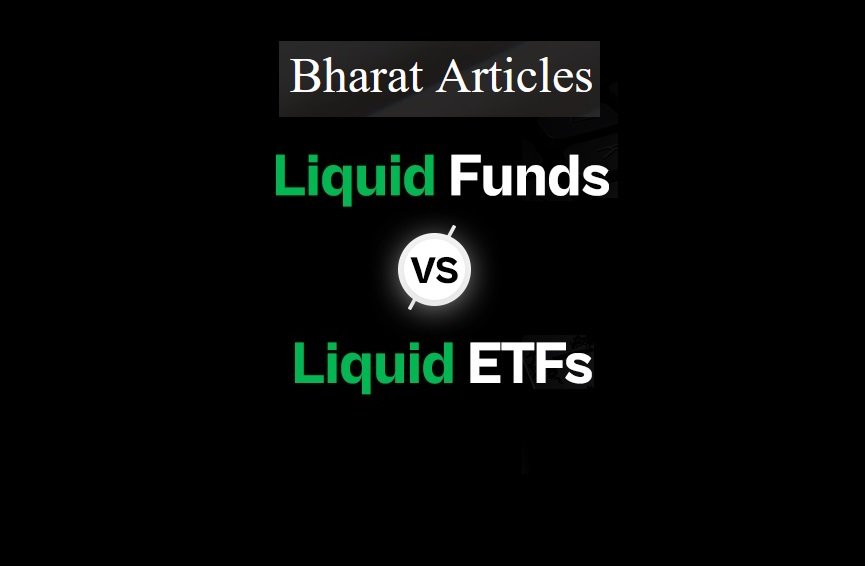Comparing Liquid Funds and Liquid ETFs: Which is Right for You?
If you’re looking to invest idle cash and earn returns, liquid funds and liquid exchange-traded funds (ETFs) are two popular options. Both are known for their liquidity and low-risk nature, offering safe investment avenues. Understanding their differences can help you choose the option that aligns with your financial goals.
What Are Liquid Funds?
Liquid funds are mutual funds that invest in highly liquid money market instruments and short-term debt securities. These include Treasury Bills (T-bills), Commercial Papers (CPs), Certificates of Deposit (CDs), and Collateralised Lending & Borrowing Obligations (CBLO) with maturities of up to 91 days. This ensures safety, high liquidity, and optimal returns, making them ideal for short-term investment needs.
What Are Liquid ETFs?
Liquid ETFs are a type of mutual fund traded on stock exchanges, investing in short-term, highly liquid debt instruments or money market securities. They are particularly beneficial for direct stock investors who want to utilize idle cash in trading accounts. Liquid ETFs serve as a temporary investment tool while still generating returns.
Key Differences Between Liquid Funds and Liquid ETFs
| Parameter | Liquid Funds | Liquid ETFs |
|---|---|---|
| Liquidity | Redemption processed at next day’s NAV | Can be bought/sold during trading hours at current market prices |
| Suitability | Suitable for short-term investors seeking safety and ease of use | Suitable for investors familiar with stock markets and requiring intraday liquidity |
| Transaction Costs | No brokerage fees, though exit loads may apply for early withdrawals | Brokerage charges apply for buying and selling |
| Expense Ratio | Slightly higher than ETFs | Lower expense ratio, making it more cost-effective |
| Accessibility | Can be invested in via mutual fund houses, banks, or online platforms | Requires a demat account |
| Customisation | Offers tailored options for various risk levels and timeframes | Limited to available ETFs in the market |
| Taxation | Taxed based on income slab for under one year; LTCG with indexation after a year | Short-term (STCG) applies for under a year; LTCG for over a year, similar to stocks |
Advantages of Liquid Funds
- Low Risk: Principal protection with steady returns, unaffected by market interest rate volatility.
- Quick Access to Funds: Redeemable within one working day (T+1); some offer instant redemption.
- Cost-Effective: Expense ratios below 1%, requiring less active management.
- Flexible Investment Period: Allows investments for any duration, with exit loads only for withdrawals within seven days.
Advantages of Liquid ETFs
- Maximized Returns: Earns interest immediately after trade settlement, avoiding idle cash.
- Flexibility: Offers easy withdrawal and serves as a short-term investment alternative to savings accounts.
- Convenience: Eliminates the need to transfer funds between trading and bank accounts.
- Exemption from Securities Transaction Tax (STT): Lowers costs, making it attractive for short- and long-term investors.
Who Should Invest in Liquid Funds?
- Bank Deposit Investors: Seeking better returns than fixed or savings deposits.
- Emergency Fund Savers: Parking contingency funds with high liquidity and low risk.
- Short-Term Investors: Ideal for horizons of up to three months due to short-maturity securities.
- Equity Fund Investors: Transitioning funds to equity investments while earning stable returns with low risk.
Who Should Invest in Liquid ETFs?
- Investors preferring steady daily returns without locking in funds.
- Those seeking a safe place for idle cash while exploring other investment opportunities.
- Active traders who can also pledge ETF holdings as collateral for margin trading.
Liquid Funds vs. Liquid ETFs: Which to Choose?
- For stock market participants: Liquid ETFs are ideal for earning returns on idle cash in trading accounts.
- For non-traders: Liquid funds are more suitable as they don’t require a demat account, have lower costs, and offer fractional unit redemption.
By understanding the features and benefits of both, you can make an informed decision that aligns with your financial needs and investment style.
Disclaimer: This article is for informational purposes only and does not constitute financial advice. Investing involves risk. Consult with a qualified professional before making any investment decisions.






